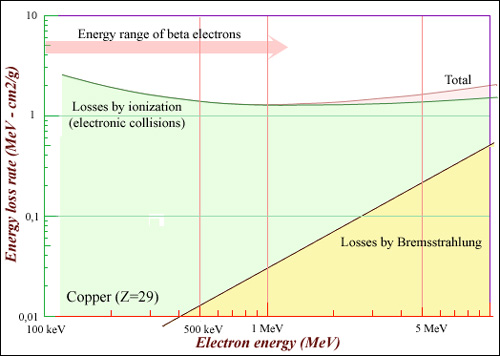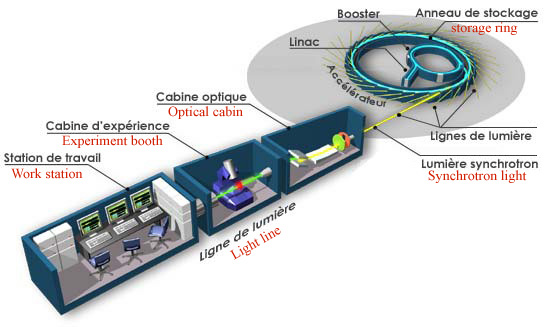A relativistic phenomenon that applies to electrons and positrons…

The Bremsstrahlung process
An ultra relativistic electron passing near a nucleus feels its strong electric field. The interaction between electric charges is explained in modern physics by the exchange of photons. In (A), the electron exchanges an internal photon with the nucleus. In (B), it emits a photon to be observed, the “braking” photon. The electron has lost energy, its trajectory has been deflected. If the electron does not pass very near the nucleus, the exchange is soft, so that the bremsstrahlung photon energy is low (infrared, visible, UV …). On the contrary if the exchange is ‘hard’, the bremsstrahlung produces an X or gamma ray.
© IN2P3
The phenomenon of bremsstrahlung (from « braking radiation » in German) applies mostly to particles with an electrical charge whose velocity is close to the speed of light. It occurs when this ultra relativistic particle interacts with a strong electric or magnetic field, which can be natural (the electric field of a nucleus) or produced by man (the field of magnets in an accelerator). The electrons and positrons easily reaching speeds close to that of light because of their very low mass are the first concerned by the phenomenon, and the only ones in the field of radioactivity.
Bremsstrahlung plays a marginal role in the field of radioactivity, since beta decay electrons do not often travel fast enough. On the contrary, it plays an important role in cosmic rays and in particle accelerators.
While interacting with a strong electromagnetic field, the electron or positron emits a photon that carries a share of its energy. The particle slows down and its trajectory is deflected. The bremsstrahlung is causing energy losses in big particle accelerators such as colliders where the particles are subject to the action of powerful magnets that bend their trajectories. Accelerator engineers must constantly compensate these losses.
These losses that annoys accelerator engeneers, are viewed as a benediction by physicists that need intense sources of radiation, ranging from infrared to gamma rays. Special synchrotrons accelerators are designed to provide abundant bremsstrahlung photons. Physicists call them synchrotron radiation.

A marginal process for radioactivity’s betas
Comparison of bremsstrahlung and ionization electrons energy loss rates in a medium such as copper (Z = 29). The thickness of an absorber is usually expressed in grams per cm2. For beta electrons of radioactivity whose energy are generally less than 1 MeV, the contribution of bremsstrahlung – that increases with energy – remains small or marginal. This energy loss would be multiplied by 8 with heavy absorbers such as lead (Z = 82).
© IN2P3
Synchrotrons have been built specially for this purpose for 20 years. Each beamline of the Synchrotron SOLEIL near Orsay constitute a full laboratory for analysis in biology, chemistry or earth science.
The bremsstrahlung is still used in radiotherapy, where small linear accelerators produce electron beams that can be either used directly for treatment at a shallow depth, or transformed into gamma rays using alternating magnetic fields.
Thus X-ray beams are obtained which can be adjusted at will in direction and energy.The bremsstrahlung occurs quite rarely in radioactivity, when beta electrons travel near the strong electromanetic fields close to atomic nuclei.

The SOLEIL synchrotron
In a facility such as the SOLEIL synchrotron, electrons of very high energy (their nominal energy is of 2750 MeV) rotate at nearly the speed of light in a 354 m circumference storage ring. The emission of radiation is tangent to the trajectory in an extremely thin “light” line, when the electrons trajectory is curved with a magnetic field that plays the role of the nuclei electric field. The synchrotron radiation, produced in bending magnets and Wigglers inverters used for insertions), is filtered in energy or wavelength and directed by optical systems in beamlines towars experimental stations.
© Synchrotron-SOLEIL
The vast majority of beta electrons energies are below one MeV, well below the energies of electrons circulating in an accelerator. It would require electrons of several MeV for the bremsstrahlung energy loss to outweigh the loss by ionization.
However, “radiation braking” increases as the square of the electric charge Z of nuclei present in the material. When the beta electron goes through a material made of relatively light atoms such as aluminum, plastic or water, the bremsstrahlung contribution to the slow down is minimal.
However there are cases where a shielding becomes necessary against secondary X or gamma rays radiations .This is the case for example of phosphorus-32, a radioisotope used in medicine for which the maximum beta electron energy of 1.7 MeV is large. Conventional shieldings with heavy materials such as lead (Z = 82) are contraindicated because they promote bremsstrahlung X or gama rays. Low-density materials should be used instead for screening such as plexiglas, plastic, wood or water with atomic nuclei that would decelerate less the electron and generate less energetic and penetrating bremsstrahlung X or gamma rays.
ALSO : Photoelectric Effect (gamma/electron)
ALSO : Compton Effect (gamma/electron))
Other articles on the subject « Radiations effects in matter »
Charged Particle Effects
A gradual loss and transfer of energy Alpha rays, fission products ; heavy, slow and ionizing par[...]
Alpha Rays in Matter
An atomic bulldozer, strongly ionizing along a very short path Alpha particles are simultaneously[...]
Beta Rays in Matter
Light electrons : a chaotic journey through matter Beta electrons and positrons have equal and op[...]
Neutral Particle Effects
Energy transfer by proxy… Neutral particles that are of interest in the field of radioactiv[...]
Cherenkov Effect
When an electron goes faster than light in air and water … The Cherenkov effect occurs when[...]
Cross Section
Cross section or the interaction probability of a particle Cross section is the name given by phy[...]
Gamma Rays in Matter
Gamma can be attenuated but never fully stopped The neutral gamma rays leave very different effec[...]
Photoelectric Effect
The most effective mechanism of photon absorption The photoelectric effect is the phenomenon that[...]
Compton Effect
Photons as projectiles and electrons as targets The Compton effect is the name given by physicist[...]
Macroscopic Effects
Effects on inert or organic matter The ionisation of atoms surrounding the trajectory of an alpha[...]